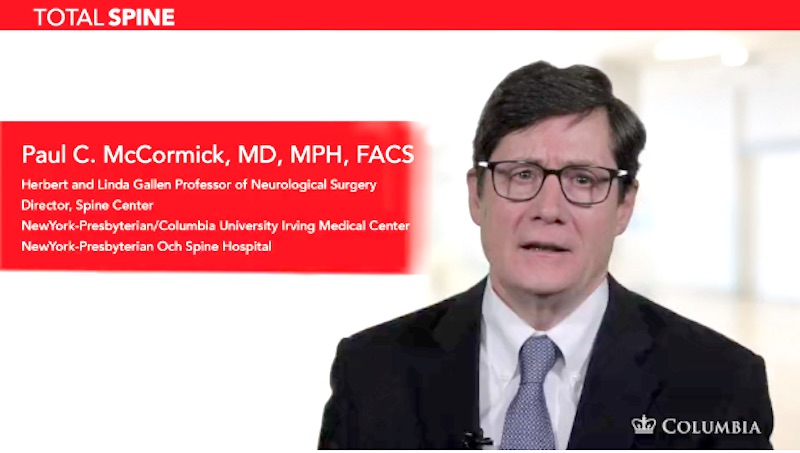| Header | Text |
| Summary | Ossification: process of changing into a bone or bone-like substance
Posterior: anatomical term meaning “further back in position”
Longitudinal: anatomical term that means “traveling long-ways”
Ligament: soft tissue that connects and supports the bones of joints
Ossification of the posterior longitudinal ligament (OPLL) is a condition in which a flexible structure known as the posterior longitudinal ligament becomes thicker and less flexible.
The posterior longitudinal ligament connects and stabilizes the bones of the spinal column. It runs almost the entire length of the spine, from the 2nd vertebra in the cervical spine (neck) all the way down to the sacrum (end of the spine). The ligament is adjacent to the spinal cord.
OPLL most often occurs at the cervical spine (spine in the neck).
Here at The Spine Hospital at the Neurological Institute of New York, we specialize in treating OPLL.
|
| Symptoms | OPLL typically begins with no or mild symptoms. Mild symptoms may include mild pain, tingling, and/or numbness in the hands. OPLL can also cause dysesthesia, an unpleasant sensation that accompanies touch. Sometimes an unpleasant sensation may be present without any touch.
As OPLL progresses, symptoms typically become more severe. If the ligament takes up valuable space within the spinal canal as it thickens, it may compress (squeeze) the spinal cord, producing myelopathy. Symptoms of myelopathy (spinal cord compression) include difficulty walking and difficulty with bowel and bladder control. OPLL may also cause radiculopathy, or compression of a nerve root. Symptoms of cervical radiculopathy include pain, tingling, or numbness in the neck, shoulder, arm, or hand.
The majority of cases will include a slow progression of symptoms, but in some cases, symptoms may suddenly become worse after a mild injury.
|
| Causes and Risk Factors | The causes of OPLL are not fully understood. Genetic, hormonal, environmental, and lifestyle factors seem to play a role.
OPLL is usually detected in men in their 50’s and 60’s. It is most common in individuals with Asian, especially Japanese, ancestry.
|
| Tests and Diagnosis | If a patient presents with symptoms associated with OPLL, the doctor may order the following diagnostic procedures:
- X-ray (also known as plain films) –test that uses invisible electromagnetic energy beams (X-rays) to produce images of bones. Soft tissue structures such as the spinal cord, spinal nerves, the disc and ligaments are usually not seen on X-rays, nor on most tumors, vascular malformations, or cysts. X-rays provide an overall assessment of the bone anatomy as well as the curvature and alignment of the vertebral column. Spinal dislocation or slippage (also known as spondylolisthesis), kyphosis, scoliosis, as well as local and overall spine balance can be assessed with X-rays. Specific bony abnormalities such as bone spurs, disc space narrowing, vertebral body fracture, collapse or erosion can also be identified on plain film X-rays. Dynamic, or flexion/extension X-rays (X-rays that show the spine in motion) may be obtained to see if there is any abnormal or excessive movement or instability in the spine at the affected levels.
- Computed tomography (CT) scan— a diagnostic imaging procedure that uses a combination of X-rays and computer technology to produce detailed images of any part of the body, including the bones, muscles, fat, and organs. CT scans are more detailed than general X-rays.
- Magnetic resonance (MR) imaging — a diagnostic procedure that uses a combination of large magnets, radio waves, and a computer to produce detailed images of organs and structures within the body. MR imaging scans use no radiation. They may not be possible in patients with certain implants or devices, such as pacemakers or old aneurysm clips.
|
| Treatments | When symptoms are mild and not progressive, OPLL can be addressed with nonoperative measures. Nonoperative treatments may include pain medications, anti-inflammatory medications, anticonvulsants, non-steroidal anti-inflammatory drugs (NSAIDs) and topical opioids.
However, surgery may be considered if a patient develops signs or symptoms of myelopathy, such as abnormal reflexes or difficulty walking, or if there is radiographic evidence of injury or ongoing compression of the spinal cord.
The surgeon may perform any of the following procedures:
The surgeon will determine the best treatment for each patient and situation. Treatment decisions will depend on a variety of factors, such as the degree of myelopathy, spinal deformity, and the number of segments involved.
|
| Preparing for Your Appointment | Drs. Paul C. McCormick, Michael G. Kaiser, Peter D. Angevine and Patrick C. Reid are experts in treating OPLL. They can also offer you a second opinion.
|


